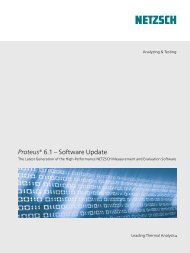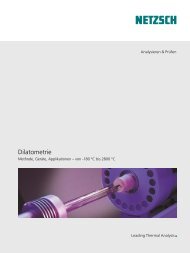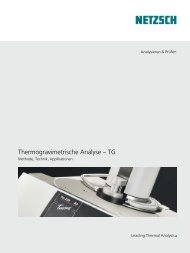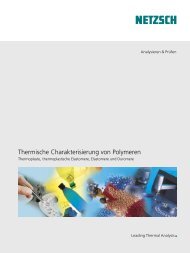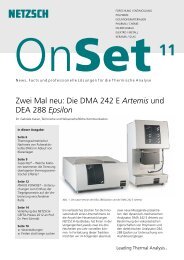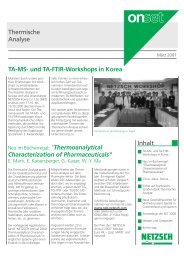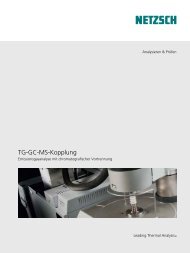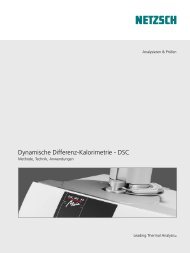TIpS & TRICKS - NETZSCH Thermal Analysis
TIpS & TRICKS - NETZSCH Thermal Analysis
TIpS & TRICKS - NETZSCH Thermal Analysis
You also want an ePaper? Increase the reach of your titles
YUMPU automatically turns print PDFs into web optimized ePapers that Google loves.
DSC<br />
14<br />
TIPS & <strong>TRICKS</strong><br />
<strong>TIpS</strong> & <strong>TRICKS</strong><br />
Determination of the Oxidation Stability of Fats and Oils<br />
Dr. Gabriele Kaiser, Technical and Scientifi c Communications, and Dr. Stephan Schmölzer, NGB Applications Laboratory<br />
Melting<br />
N 2 / 50 ml/min<br />
OIT<br />
O 2 / 50 ml/min<br />
time<br />
Fig. 1. Determination of the Oxidation Induction Time for a polyolefi n as per ISO 11357-6<br />
External infl uences such as UV radiation<br />
(light), temperature, atmospheric<br />
oxygen, mechanical load or chemical/<br />
biological media lead to premature<br />
aging in materials, resulting in a<br />
change in their chemical and physical<br />
properties. Proper aging inhibitors<br />
(stabilizers) slow down the aging process<br />
and prolong the induction period,<br />
i.e. the time span preceding the onset<br />
Fig. 2. <strong>NETZSCH</strong> High-Pessure DSC 204 HP (max. pressure: 150 bar)<br />
Temp.<br />
220°C<br />
180°C<br />
of thermo-oxidative decomposition<br />
(chain degradation, technical failure).<br />
An important indicator of the oxidation<br />
stability of oils, fats, lubricants,<br />
fuels or plastics is the Oxidation<br />
Induction Temperature or Oxidation<br />
Induction Time (O.I.T.), which can be<br />
determined by means of DSC in standardized<br />
procedures.<br />
In practice, two different methods are<br />
used: dynamic and isothermal O.I.T.<br />
tests. In the dynamic technique, the<br />
sample is heated at a defi ned constant<br />
heating rate under oxidizing<br />
conditions until the reaction begins.<br />
The corresponding Oxidation Induction<br />
Temperature is the same as the<br />
extrapolated onset temperature of the<br />
exothermal DSC effect which occurs.<br />
In isothermal O.I.T. tests, the materials<br />
to be investigated are fi rst heated<br />
under a protective gas, then held at a<br />
constant temperature for several<br />
minutes unter protective gas to establish<br />
equilibrium, and subsequently<br />
exposed to an atmosphere of oxygen<br />
or air. The time span from the fi rst<br />
contact with oxygen until the beginning<br />
of oxidation is called the Oxidation<br />
Induction Time. This is shown in<br />
fi gure 1.<br />
Many national and international<br />
standards – such as ASTM D 3895<br />
(polyethylene), DIN EN 728 (plastic<br />
pipelines), ISO 11357-6 (plastics) and<br />
ASTM D 525 (aircraft fuel) – give<br />
recommendations for sample preparation<br />
and proper selection of the<br />
measurement conditions.<br />
Oxidation tests on lubricating oils and<br />
greases are usually carried out using<br />
a high-pressure DSC instrument (see<br />
fi gure 2). A back-pressure is generated<br />
– generally 35 bar – in an attempt to<br />
prevent evaporation of the sample.<br />
In oxidation reactions, however, the<br />
oxygen not only serves for pressure<br />
generation, but also as a reaction partner.<br />
For this reason, both the pressure<br />
and the gas fl ow must be regulated<br />
with the utmost precision.<br />
Determination of the oxidation stability<br />
is “surface-sensitive”. This means<br />
that the oil or grease fi lm to be investigated<br />
should ideally exhibit a smooth,<br />
uniform surface in order to ensure
high reproducibility of the test results.<br />
Very well suited for such investigations<br />
are SFI crucibles (SFI stands for Solid<br />
Fat Index; see diagram in fi gure 3), as<br />
recommended in ASTM D 5483 for<br />
lubricating greases and ASTM D 6186<br />
for lubricant oils.<br />
An example of these would be panshaped<br />
aluminum crucibles with an<br />
outer diameter of 6.7 mm and a<br />
volume of 85 µl which can be shaped<br />
with a sealing tool (built into a standard<br />
crucible press – fi gure 4).<br />
Fig. 3. Diagram of an SFI crucible with sample<br />
(green)<br />
Fig. 4. Sealing press and insert (enlarged scaling)<br />
In crucibles with a fl at bottom, oils<br />
and greases often creep to the rim<br />
TIPS & <strong>TRICKS</strong><br />
Fig. 5. Comparison of the O.I.T. times of a grease analyzed in a standard aluminum crucible (blue)<br />
versus an SFI crucible (green); instrument: DSC 204 HP; 35 bar oxygen<br />
zones at higher temperatures. The<br />
effective surface of the sample which<br />
can interact with the surrounding<br />
atmosphere is thus reduced in size.<br />
This affects the O.I.T. result (see fi gure<br />
5). When the analysis is conducted in<br />
an open standard aluminum crucible<br />
(blue curve), the O.I.T. time (extrapolated<br />
onset) amounts to 64.6 min.<br />
In comparison, when analyzed in an<br />
SFI crucible (green curve), the O.I.T. is<br />
shortened considerably (to 46.4 min)<br />
due to the larger effective surface.




